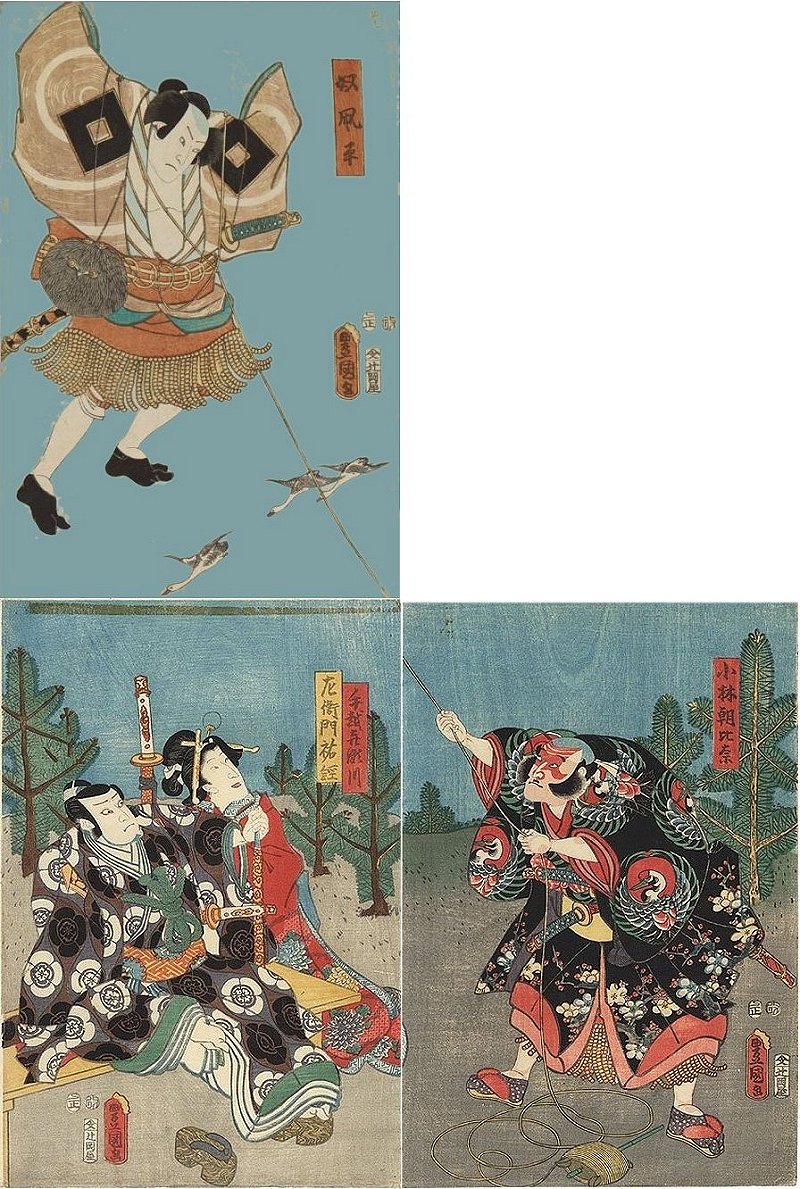| |
KUNISADA(Toyokuni-III)(1786 - 1864)"Ordinary Yakko Kite" (Tsujioka-ya Bunsuke edition) |

"Ordinary Yakko
Kite"
(Yakko-dako taira, 奴凧平)
Series: "8 Pieces Collection"
(Hachi Mai-Soroi, 八枚揃)
(Yakko-dako taira, 奴凧平)
Series: "8 Pieces Collection"
(Hachi Mai-Soroi, 八枚揃)
Tsujioka-ya Bunsuke Edition
1857
Comment - The title of the tetraptych
is written in the red cassette on the upper left panel "奴凧平").
The theme is a kabuki
scene from the stage play "Tegoshi Kise River" ("Tegoshi
Kise-gawa", "手越喜瀬川"), as stated in the yellow cassette, lower
left panel. Young pine trees dot the landscape behind the
scene, reminding kadomatsu
trees, thus hinting to the New Year season.
A flying Yakko or man kite ("yakko-dako", "奴凧"), played by kabuki star Ichikawa Ichizō-III (市川市蔵) is floating in the sky. He wears the distinctive clothing of a yakko or low ranking servant, a kimono with a striped collar and a diamond crest on the shoulders, his sword tucked in the obi behind him. The Yakko carries a funny bag with two eyes and suggested bird-of-prey beak on a kind of wooly head, maybe depicting a head of an owl. The bag is tied with simple cords to his right shoulder. The Yakko hangs in the air, his sleeves extended like wings, looking down with a frown. While in the air, three geese are crossing below him.
The kite is tied to the yakko kite, the line
extending over the lower right selvage to the kabuki character
Kobayashi Asahina ('小林
朝比奈') on the lower right panel. Kabuki star Nakamura
Fukusuke-I (中村福助) plays the character 'Kobayshi Asahina' ('小林
朝比奈') as written on the yellow cassette right panel, upper
left side, as written on the red cassette right panel, on the
pine tree.. Strongman Asahina looks up with concentration as
he lets out the string. A spool lying on the ground beside
him. Asahina is instantly recognizable because of his kumadori
or "monkey make-up" and black robe patterned with medallions
of cranes with outstretched wings and blossoming plum
branches. The crane is the traditional crest of Asahina. He
also wears dotted socks and sandals with fuzzy red straps.
The lower left panel shows a beauty with a
smile watching her her companion, actor Saemon Suketsune
(左衛門祐経) aka Nakamura Shikan (中村芝翫), written in the red
cassette. He seems to be alarmed, his eyes wide open. The
actors are sitting on a lw bench, both having a sword tucked
in their obi.
The same setting of panels of the Maruya
edition shows swallows flying in the sky, and
Mount Fuji in the background. The swallow (tsubame) comes from
the south in spring, and leaves in autumn. Thus the swallow is
the typical indicator for summer. This Tsujioka-ya
Bunsuke edition shows geese flying in the sky, and no
sketch of Mount Fuji. Geese especially when flying in
triangular formation across the moon indicate autumn. Maybe
the two different sets hint to the different theater seasons.
Series - "8 Pieces Collection" or
"Hachi Mai-Soroi" (Yuika Ogawa Yukiyuki Omi - Kunihisa-ga
Sandai-Toyokuni-ga - Hachi Mai-soroi,
濡衣女鳴神 近江八勇之内 国久画 三代豊国画 八枚揃)
Artist - see Biography
Signature - Toyokuni-ga (豊国 画), in streched oval brownish-red toshidama cartouche (Otoshidama-in, 年玉印), on all panels; date and censor seals above otoshidamas on all panels
Publisher - Tsujioka-ya Bunsuke (辻岡屋文助), (Kinshōdō publishing, 松堂), white seal next to the Otoshidama on all panels
Image Size - 39.1 x 23.8cm (15 3/8" x 9 3/8") (each panel)
Condition - single panels (three parts of a tetraptych); nishiki-e (cloured woodblock); vertical ôban (ôban tate-e);
Artist - see Biography
Signature - Toyokuni-ga (豊国 画), in streched oval brownish-red toshidama cartouche (Otoshidama-in, 年玉印), on all panels; date and censor seals above otoshidamas on all panels
Publisher - Tsujioka-ya Bunsuke (辻岡屋文助), (Kinshōdō publishing, 松堂), white seal next to the Otoshidama on all panels
Image Size - 39.1 x 23.8cm (15 3/8" x 9 3/8") (each panel)
Condition - single panels (three parts of a tetraptych); nishiki-e (cloured woodblock); vertical ôban (ôban tate-e);